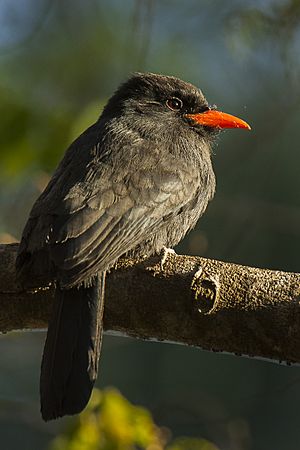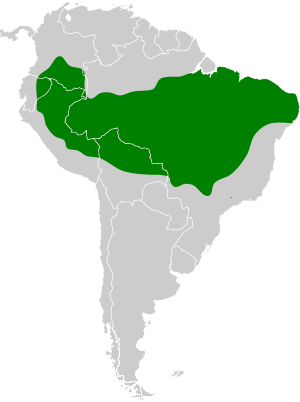Black-fronted nunbird facts for kids
Quick facts for kids Black-fronted nunbird |
|
|---|---|
 |
|
| Conservation status | |
| Scientific classification | |
| Genus: |
Monasa
|
| Species: |
nigrifrons
|
 |
|
The black-fronted nunbird (Monasa nigrifrons) is a cool bird that lives in the Amazon Basin. It's part of a bird family called Bucconidae, which includes puffbirds and other nunbirds. You can find this bird in countries like Bolivia, Brazil, Colombia, Ecuador, and Peru.
Contents
What is a Black-fronted Nunbird?
How is it Classified?
The black-fronted nunbird has two main types, or subspecies: M. n. nigrifrons and M. n. canescens. Scientists sometimes group it with other similar birds, like the black nunbird and the white-fronted nunbird, because they are very closely related.
What Does it Look Like?
This bird is about 26 to 29 centimeters (10 to 11 inches) long. That's about the length of a ruler! It weighs between 68 to 98 grams (2.4 to 3.5 ounces).
Most of the black-fronted nunbird's body is a dark, sooty black color. It's darkest around its beak, which is bright red. Its eyes are dark, and its legs are black. The back part of its body is a blue-gray, and its tail is blue-black. One of its subspecies, M. n. canescens, looks a bit lighter and grayer than the main type. Young nunbirds are a dull gray with some reddish spots.
Where Do Black-fronted Nunbirds Live?
Their Home Range
The main type of black-fronted nunbird (M. n. nigrifrons) lives in many parts of the Amazon Basin. You can find it in southeastern Colombia, eastern Ecuador, eastern Peru, and a large part of Brazil. In Brazil, it lives both north and south of the Amazon River.
The other subspecies, M. n. canescens, is found only in eastern Bolivia.
What Kind of Places Do They Like?
Black-fronted nunbirds prefer to live near rivers and lakes. They love areas with lots of trees and bamboo. You might see them in forests that flood, like várzea and igapó forests, or in forests that grow along rivers, called gallery forests.
They also live in forests that are regrowing (secondary forests), on swampy river islands, and in forests that are changing from young to old. Unlike some other nunbirds, they don't usually live in terra firme forests, which are higher and don't flood. These birds can be found from sea level up to about 1,000 meters (3,300 feet) high.
How Do Black-fronted Nunbirds Behave?
What Do They Eat?
Black-fronted nunbirds are good hunters! They catch most of their food while flying. They also pick up food from the ground or from leaves up to about 6 meters (20 feet) high. Their diet mainly includes insects and other small creatures like spiders. They also eat small lizards and amphibians.
Sometimes, they follow groups of monkeys or swarms of army ants. This helps them catch prey that the monkeys or ants stir up. They might even join other types of birds to hunt together in mixed groups.
How Do They Raise Their Young?
The breeding season for black-fronted nunbirds changes depending on where they live, but it's usually from April to October. They make their nests by digging a hole in a bank or in flat, gently sloping ground. A female nunbird usually lays three eggs at a time.
What Do They Sound Like?
The song of the black-fronted nunbird is quite special. It's a fast series of pretty, rising whistles that sound like "clerry" or "curry." These are sometimes broken up by a downward trill that sounds like "turra turra." Often, several nunbirds will sing this song together, creating a chorus!
Are Black-fronted Nunbirds Safe?
The IUCN (International Union for Conservation of Nature) says that the black-fronted nunbird is a species of "Least Concern." This means they are not currently in danger of disappearing. They live across a very large area. Even though their exact numbers aren't known, and their population might be slowly shrinking, they are still common or even abundant in most places where they live.
See also
 In Spanish: Monja Unicolor para niños
In Spanish: Monja Unicolor para niños


